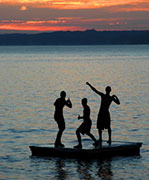
THURSDAY, March 5, 2015 (HealthDay News) — The cases of two men who got injured while enjoying the great outdoors in Missouri and Texas are giving insight into a freshwater algae that can infect wounds.
Reporting in the March 5 issue of the New England Journal of Medicine, the researchers say it’s the first time that the algae — a species common in rivers and lakes called Desmodesmus armatus — has been conclusively linked to wound infections.
Both men were hospitalized for their wounds, and the germ triggered infection of the injured tissue while they were in the hospital. Both men recovered, but not until some of the affected tissue was removed, said study senior author Dr. Bradley Ford, director of clinical microbiology at the University of Iowa Hospitals and Clinics in Iowa City.
He stressed, however, that even though the algae is common, “we’re [still] talking about an extremely rare type of infection and it’s extremely unlikely it will ever hurt more people.”
One case involved a healthy 24-year-old man who suffered a deep puncture to his right foot while in a freshwater lake in Texas.
The other case involved a healthy 30-year-old man who had a serious accident while jet-skiing in a freshwater lake in Missouri.
Both were initially hospitalized for their injuries. Once in the hospital, however, each developed telltale signs of a localized infection — swelling and redness, as well as warming and pain in and around the wound.
Fungal cultures performed on tissue samples drawn from each patient revealed that both had been infected with the same type of chlorophyll algae — D. armatus.
Both men underwent surgery to remove a minimal amount of infected tissue, a process called debridement. Both recovered, although the Missouri patient did subsequently struggle with a related antibiotic-resistant complication one year later, Ford said.
“Ultimately both recovered fully, after repeated removal of local tissue,” he said. “There were no amputations or anything dramatic of that kind.”
Should most Americans take any special precautions in the nation’s rivers and streams, based on these cases? Ford thinks not.
The new cases involved contact with green-tinted, chlorophyll-rich algae “that are in the billions surrounding us,” he said. “We see green in freshwater everywhere. But there are hardly any infections related to this. Which says to me that these algae usually don’t have much potential as pathogens — even though we do know of infection cases going a long way back.”
Ford believes the case reports are important for “getting a better handle on algae infections overall and perhaps helping doctors to know what to do when and if they see this type of very, very rare infection.”
Elizabeth Scott is co-director of the Center for Hygiene and Health in Home and Community at Simmons College in Boston. She agreed that the overall risk to the public from the algae is extremely low, except perhaps to people with weakened immune systems.
“Immuno-compromised individuals can generally help reduce their risk of infection from waterborne pathogens by showering with soap after water activities, by cleaning and dressing skin wounds as soon as possible, by not entering natural waters with a pre-existing skin wound, and by seeking medical attention for wounds that have occurred during water activities,” she said.
More information
There’s more on risks related to freshwater algae at the U.S. Centers for Disease Control and Prevention.
Copyright © 2025 HealthDay. All rights reserved.

